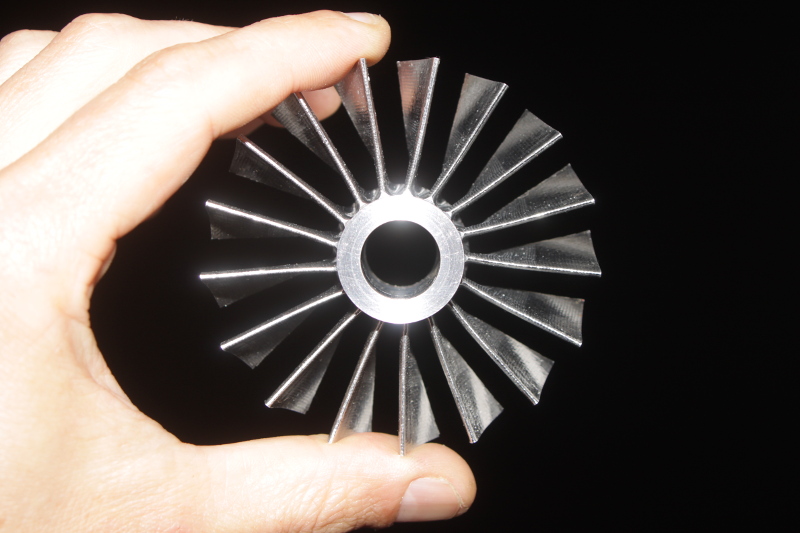Post by gtbph on Feb 16, 2016 5:56:48 GMT -5
This is also a part of my engine build, but I thought it would be better to make a new thread for this.
It's an attempt to build a small and light electric igniter. Anders posted a very interesting thing here, I will also try this because this would be even smaller. But sparks are interesting anyway, and I had been thinking a lot about these spark makers so I had to try now.
The design is similar to this one made by Thomas Baumgart ("turbotom"). The main differences are that I use
- a device called "SIDAC", instead of a printed spark-gap,
- a smaller, lower voltage, but higher capacity, electrolytic storage capacitor instead of a film capacitor from a microwave oven.
I think that a microwave capacitor makes a better spark though, so this is a bit a compromise. The sparks that this device makes are not extremely loud, I think the spark lasts longer but has a lower peak intensity, and may wear the spark plug more.
This is a first test of the spark-making part of the circuit:

I used 230V from the socket directly instead of a fly-back high voltage generator that will make this work from a battery.
You can see
- the 400V, 68uF electrolytic capacitor on the left,
- some small blue 630V, 0.47uF ceramic caps, two 1000V schottky diodes and a 1M resistor in the middle,
- the 20mm transformer (3:100 turns) and the 230V SIDAC on the right.
- The large blue film cap on the bottom will not be used in the final design, it's just used as a current limiter here.
In this video I try to set a piece of paper soaked in lamp oil on fire:
Of course this does not mean that it will work in the engine, but I have no better way to test this at the moment. I tried to set the oil on fire with a lighter to show that it's not something very easily flammable like gasoline.
The smaller "misfire" sparks that you can see when I put the paper in the spark gap happen when the storage cap does not discharge because the resistance of the first "trigger" spark is too high for the voltage in the storage cap to maintain the spark. I hope this will be better with the fly-back generator, because I can use a higher voltage. I will also soak the transformer in epoxy resin for better insulation, and together with the higher voltage it should also make longer sparks.
To be continued...
Alain
It's an attempt to build a small and light electric igniter. Anders posted a very interesting thing here, I will also try this because this would be even smaller. But sparks are interesting anyway, and I had been thinking a lot about these spark makers so I had to try now.

The design is similar to this one made by Thomas Baumgart ("turbotom"). The main differences are that I use
- a device called "SIDAC", instead of a printed spark-gap,
- a smaller, lower voltage, but higher capacity, electrolytic storage capacitor instead of a film capacitor from a microwave oven.
I think that a microwave capacitor makes a better spark though, so this is a bit a compromise. The sparks that this device makes are not extremely loud, I think the spark lasts longer but has a lower peak intensity, and may wear the spark plug more.
This is a first test of the spark-making part of the circuit:

I used 230V from the socket directly instead of a fly-back high voltage generator that will make this work from a battery.
You can see
- the 400V, 68uF electrolytic capacitor on the left,
- some small blue 630V, 0.47uF ceramic caps, two 1000V schottky diodes and a 1M resistor in the middle,
- the 20mm transformer (3:100 turns) and the 230V SIDAC on the right.
- The large blue film cap on the bottom will not be used in the final design, it's just used as a current limiter here.
In this video I try to set a piece of paper soaked in lamp oil on fire:
Of course this does not mean that it will work in the engine, but I have no better way to test this at the moment. I tried to set the oil on fire with a lighter to show that it's not something very easily flammable like gasoline.
The smaller "misfire" sparks that you can see when I put the paper in the spark gap happen when the storage cap does not discharge because the resistance of the first "trigger" spark is too high for the voltage in the storage cap to maintain the spark. I hope this will be better with the fly-back generator, because I can use a higher voltage. I will also soak the transformer in epoxy resin for better insulation, and together with the higher voltage it should also make longer sparks.
To be continued...
Alain



